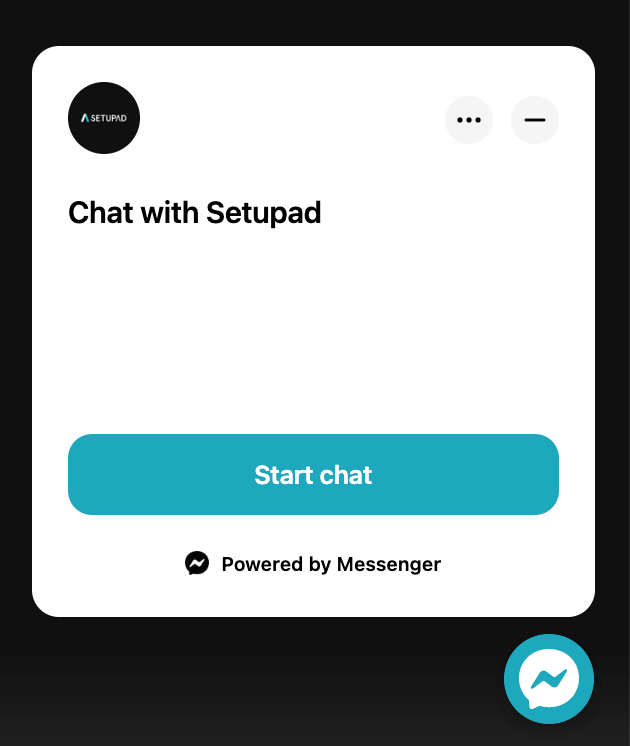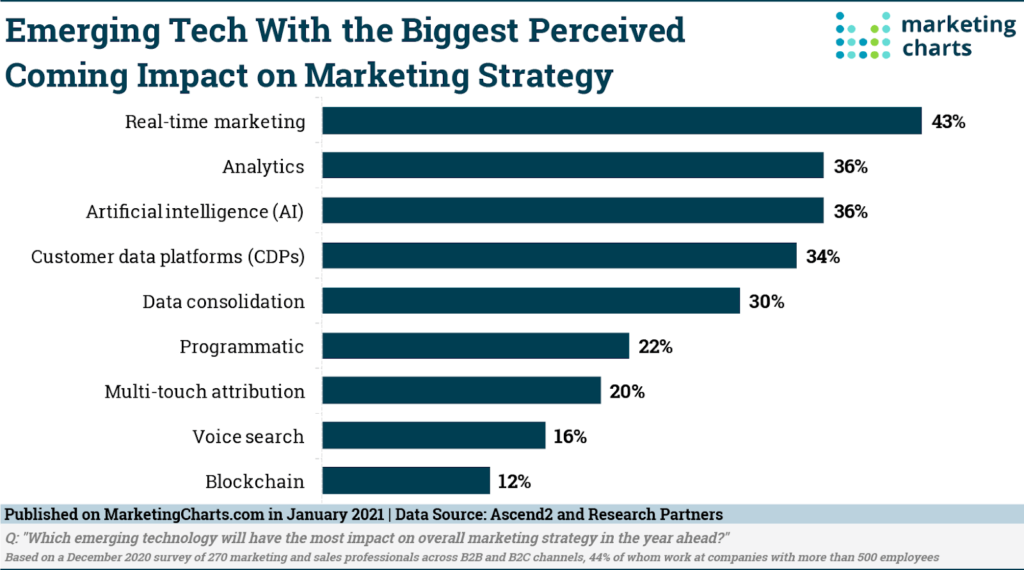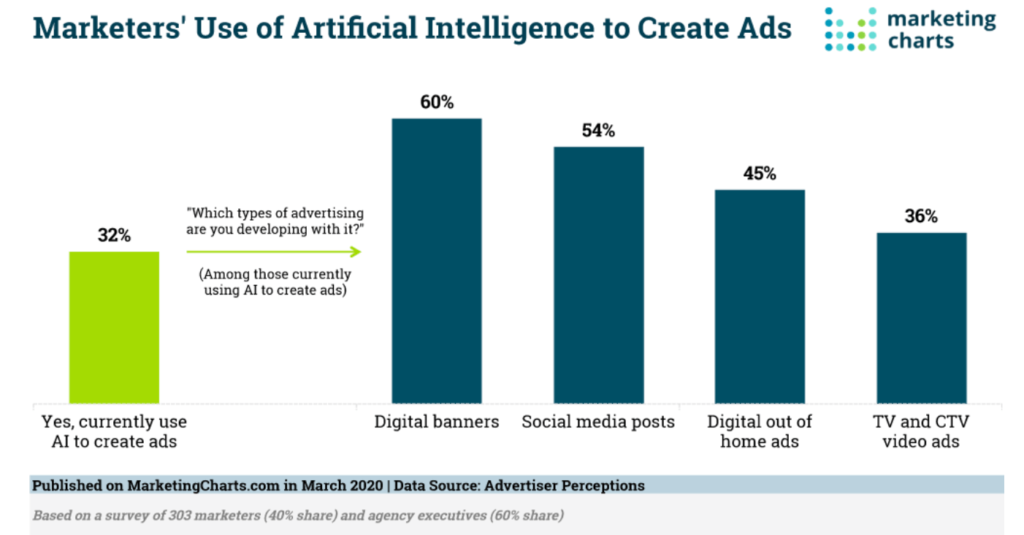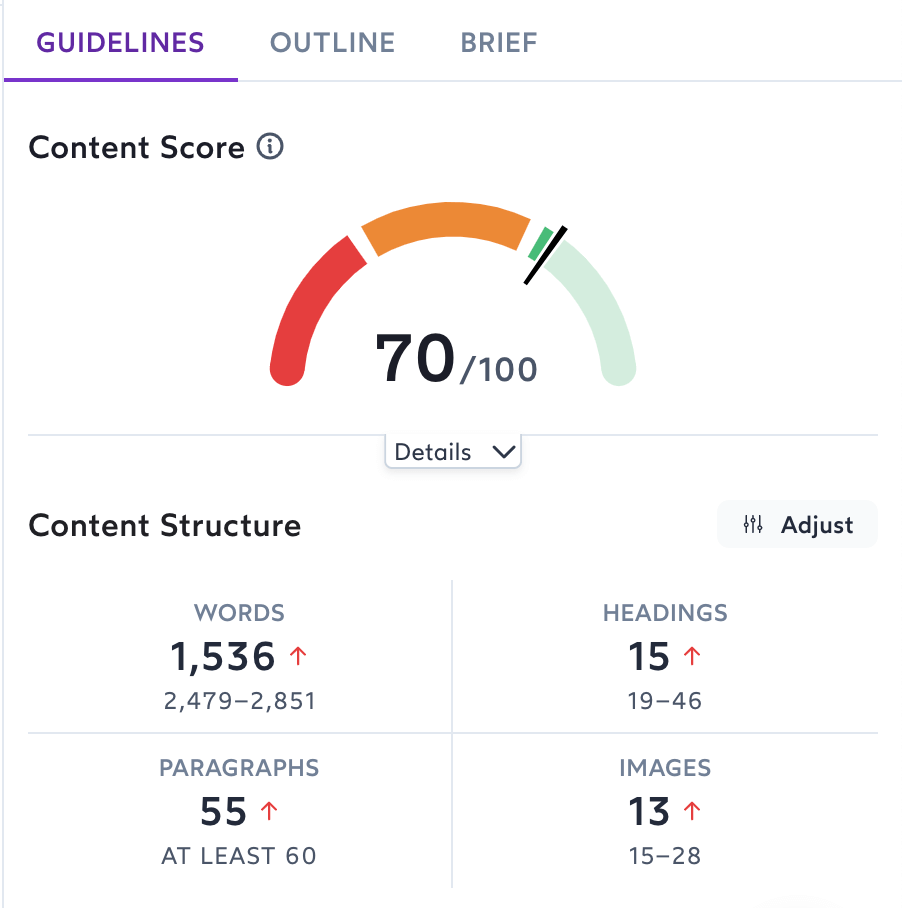The Future of AI in Digital Marketing
AI is already used in digital marketing on a large scale today. Companies, marketing agencies, and individuals are adopting AI’s advancements and advantages.
These are only a few real-life examples of AI in use, from image recognition software to AI chatbots to interpreting and responding to voice searches and commands.
Read this article to understand the many types of AI and how they can affect publishers, advertisers, and daily marketing processes.
What is AI?
AI stands for artificial intelligence, and it’s the ability of computer systems to look at content, data, and social platform usage in a human-like way. It has a cognitive ability that is different from traditional computing.
AI evolves by usage–the more you use it, the more data it receives and the more it learns and understands. It’s not meant to replace humans but to enhance human capabilities, making it a valuable business asset.
Why is AI Important for Marketers?
Generally, AI helps absorb, interpret, and make complex decisions based on data generated today, which would be hard for a human brain to do.
In advertising, AI is primarily being used to target specific audiences and optimize advertising campaigns.
But AI also has applications in other fields, such as logistics and customer experience.
For example, AI can provide valuable insights for a digital marketer about finding the right consumers, engaging with them, and conducting return-on-investment (ROI) analysis.
In the table below, you can see examples of AI’s impact on the 4 Ps (product, price, promotion, place) of marketing mix:
| Areas of AI | Examples |
| Product | • Hyper-personalisation • Automatic recommendations • New product development |
| Price | • Price management and dynamic price matching to customer profiles |
| Promotion (Brand) | • Personalized communication •Creating a unique experience |
| Place (Sales and distribution) | • Convenient shopping • Fast and easy sales process • 24/7 customer service • Service-free shops |
How do publishers implement AI?
AI tools can significantly save publishers time and effort without damaging the quality and effectiveness of created content because of automated technologies like text analysis, content personalization, formatting, SEO, auto-tagging, and more.
Big publishers usually can afford to invest money in AI because such technology is costly. Generative AI companies that offer customized solutions can help these publishers unlock advanced AI capabilities tailored to their specific needs.
Here are 3 examples of how publishers leverage AI advancements:
- Forbes. They launched Bertie, an AI-driven CMS. It is a publishing platform with AI that was created especially for the internal newsroom of journalists, expert contributor networks, and partners. It offers real-time trending subjects to cover, tips on how to write catchier headlines, and suggestions for relevant pictures.
- The Washington Post. They released Heliograf, a unique automated storytelling system developed for hyperlocal reporting. Thanks to their ability to generate whole stories from quantitative data, they can cover every high school football game played in the Washington D.C. area each week. Thanks to the Heliograf, they can cover any game for which they have statistics, and readers will be able to get coverage almost immediately.
- Bloomberg. They created a product named Cyborg. It keeps track of the management of content creation. At the end of each quarter, it can produce hundreds of pieces regarding company earnings reports. Cyborg is programmed to recognize and extract all of their crucial numbers immediately.
AI Role in Digital Marketing
With the help of AI, companies can increase their revenues by optimizing digital marketing campaigns, channels, audiences, and market performances.
AI also helps measure the impact on customers and revenues and improve customer satisfaction by creating personalized content.
There are 3 main types of AI–machine learning, deep learning, and natural language processing.
Machine Learning
Machine learning (ML) is a type of artificial intelligence that allows software applications to predict outcomes using historical data.
In other words, ML enables computers to learn by themselves from the received data and draw conclusions.
ML can be presented in different forms, such as pattern recognition, statistical modeling, data exploration, knowledge discovery, predictive analytics, data analytics, adaptive systems, self-organizing systems, etc.
Deep Learning
Deep learning (DL) is a more advanced type of machine learning because it doesn’t need to be managed manually and can instantly provide new information results.
DL systems take care of big data and computing power, for example, server farms and cloud computing. Also, it’s the key for voice control on consumer devices, such as phones, tablets, TVs, etc.
| Machine Learning | Deep Learning | |
| Data Volumes | Thousands of data points | Big data: millions of data points |
| Accuracy | Less accurate and human intervention is necessary to deal with mistakes | High accuracy and doesn’t require human assistance to deal with mistakes |
| Training Time | Takes less time to train | Takes longer to train |
| Hardware | Works on CPU (central processing unit–part of any digital computer system, generally composed of the main memory, control unit, and arithmetic-logic unit), and has limited tuning capabilities | Requires GPU (graphics processing unit–a specialized processor originally designed to accelerate graphics rendering) and can be tuned in many ways |
| How It Works? | Uses different types of automated algorithms that learn to model functions and predict future actions from existing data | Uses neural networks which process data through many processing layers to interpret data features and relationships accurately |
Natural Language Processing (NLP)
Natural language processing (NLP) is a component of ML and DL, which aims at speech recognition. NLP allows computers to understand human language as it is spoken or written.
Publishers can automate basic editing and formatting tasks using NLP technology to focus more on making high-quality content and handle more website articles.
Grammar and formatting rules can be applied in AI and NLP to automatically correct language mistakes that may require the editor’s attention (e.g., Grammarly).

How Will AI Impact Digital Media Marketing?
There are 6 main potential and existing impacts of AI on marketing functions:
- Analyzing the current situation and predicting future outcomes. AI helps marketers to understand and simplify large unstructured data, identify anomalies and likely future events, therefore helping to forecast required improvements and threats.
- Understanding markets and customer behaviour. AI helps marketers to identify changes in competitor behavior (e.g., pricing, distribution), estimate the potential product demand, and analyze customer comments, feedback, and interests to improve the overall customer experience.
- Segmentation, targeting, and positioning. AI can help to cluster customers into distinct groups, which can also improve the targeting of ads and provide more accurate product and brand recommendations to users according to their interests. It also helps publishers to organize their content structure, for example, by automatically generating topic clusters or finding a semantic relationship between articles.
- Marketing support. Implementing AI chatbots increases the quality of your customer service, as simple questions can be answered more quickly.

- Developing product and pricing strategy. AI helps to identify trends in the market, suggesting new product development or improvements to the existing ones. As AI can analyze large quantities of data, it can also help to create more personalized products and services for individual customers and estimate the consumer price elasticity of demand.
- Developing channels and logistics strategy. AI can help analyze your website’s user journey (e.g., heatmaps) and create suggestions for better site optimization. For example, tools like Hotjar can help you draw insights into where the highest user engagement is on your page.

AI in Digital Media Market Growth
According to a survey, among 270 B2B and B2C marketers, 36% of respondents think that artificial intelligence will impact the overall marketing strategy in the future.

Source: Marketing Charts
Another study found that out of 300 marketers, 32% currently use AI to create ads.

Source: Advertiser Perceptions
Top AI Trends in Digital Marketing
Here are the 8 most common AI trends in digital marketing:
- AI chatbots and AI email assistants–assure fast and easy customer communication. They can be programmed to automatically give answers to frequently asked questions, collect contact information, and handle common tech issues, saving up your time.
- Personalization–serves the most relevant content to the customer based on their browsing history, interests, and the stage of their buyer’s journey.
- AI smart content creation–helps generate different types of content, such as automated blog posts. For example, tools like SurferSEO help to craft content structure faster and boost your SEO efforts by analyzing competitors’ content and offering useful insights into keyword research.

- Voice search–searches information on the web with the power of speech recognition. Publishers should optimize schema markup (the language in which search engines communicate) for voice search to gain more voice search visitors. To do that, publishers should include answers in their content asked in a conversational manner.
- Programmatic media buying–uses algorithms and data insights to serve ads to the right user at the right time. Three main components include SSPs, DSPs, and ad exchanges.
- Targeting–adjusts ad settings based on the user’s geolocation, interests, and behavior.
- Retargeting–helps to channel ads to those site visitors who previously saw ads but didn’t convert into customers.
- Dynamic and personalized pricing–directs special offers at customers who are most likely to convert, which can increase sales and maximize profits.
Examples of Artificial Intelligence in Marketing
As AI depends on data analysis in nearly all its applications, the ever-increasing amount of consumer data available online, on big data platforms, or on mobile devices makes it a crucial ally of marketing.
There’s a large use of data in marketing, from studies of consumer demands to market analysis, customer insights, and competitor information.
As well as for pursuing activities through various communication or distribution channels and evaluating the effectiveness of implemented strategies.
Real-time bidding software
Real-time bidding (RTB) is part of the programmatic advertising process and refers to the real-time buying and selling of ad inventory.
With RTB, targeting ads to specific users is possible based on different parameters. With advanced monetization platforms like Setupad that connect publishers with 30+ SSPs, it means publishers can sell their ad inventory most effectively (for the highest possible price based on supply and demand).
Chatbots
One of the most widely used AI integrations in digital marketing is natural language processing applications–chatbots. Chatbots use NLP to communicate with the user, giving the impression that a real person is behind the chatbox.
For example, Dominos uses a Facebook chatbot on its page. This chatbot allows the user to perform a number of actions, including placing and tracking an order and contacting customer support.
Virtual assistants
AI-powered virtual assistants are similar to chatbots–but much more capable and advanced. They use next-gen analytics, machine learning, and data science to provide a more insightful and intelligent response than a chatbot.
For example–Siri and Alexa are some of the best-known examples of virtual assistants. They use voice recognition to understand and execute commands and answer user queries.
Personalized content
With its data-processing capabilities, AI can offer a much more personalized experience for the user. For example, it can read and interpret all the data gathered from the previous usage of a platform or service and make better suggestions.
This is an important feature in digital marketing, where targeting, retargeting, and user engagement are some of the most important factors for growth.
Companies like Netflix and Spotify invest in machine learning technologies that allow them to suggest relevant movies and music tailored for each consumer.
AI writers and content generators
Although Google says that AI-generated content is against their content quality guidelines, this doesn’t mean you can’t use it smartly.
For example, an eCommerce website might use AI-generated content for its products. Or, an email writing AI can dramatically ease your email workflow process by generating intro lines and email body.
Sure, there are drawbacks to these tools–they can’t provide the best personalization, but combined with a copywriter, these tools can offer great help with writing content faster.
Conclusion
AI is already helping publishers to generate content more quickly and effectively than before, and without doubt, there will be more technological advancements ahead of us.
AI shouldn’t be viewed as a threat to the human workforce but rather as a valuable tool that creates a better workflow and more effective data and user analysis, marketing strategy creation, and problem-solving.
If you have any questions left, email us at [email protected] or leave a comment below.


